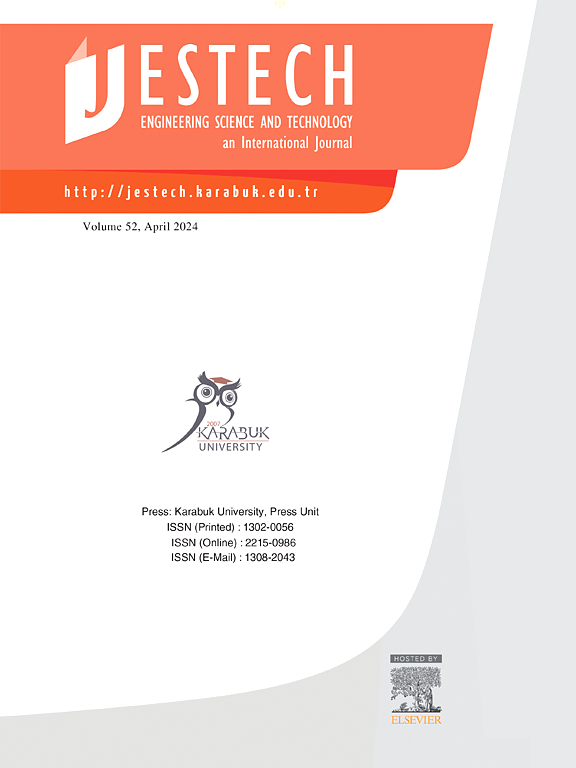Effect of scoria powder on the strength and porosity of porous concrete produced with recycled porous concrete aggregate
IF 5.1
2区 工程技术
Q1 ENGINEERING, MULTIDISCIPLINARY
Engineering Science and Technology-An International Journal-Jestech
Pub Date : 2025-07-15
DOI:10.1016/j.jestch.2025.102141
引用次数: 0
Abstract
In recent years, there has been a significant increase in the cycle of demolition and reconstruction, driven by the growing demand for housing and urbanization in developing countries. As new buildings are constructed at a rapid pace, the resulting debris from older structures presents a considerable challenge, particularly because of limited storage capacity. This study focused on the production of porous concretes using recycled aggregates. To address the low strength associated with recycled aggregates, 5 % (by weight) of silica fume was incorporated, while scoria was used to replace cement at varying levels of 5 %, 10 %, 15 %, 20 %, 25 %, and 30 % by weight. The research also analyzed the pore structure and distribution within the porous concrete through computed tomography, with an emphasis on its mechanical properties, porosity, and water permeability. The results demonstrate that scoria serves effectively as a binder, successfully substituting for cement. Additionally, the integration of scoria enhanced the compressive strength of the porous concrete after a 120-day curing period, due to pozzolanic reaction caused by scoria, while also reducing water permeability.
矿渣粉对再生多孔混凝土骨料制备的多孔混凝土强度和孔隙率的影响
近年来,在发展中国家日益增长的住房需求和城市化的推动下,拆除和重建的周期显著增加。由于新建筑物的建造速度很快,旧建筑物产生的碎片提出了相当大的挑战,特别是因为存储容量有限。本研究的重点是利用再生骨料生产多孔混凝土。为了解决与再生骨料相关的低强度问题,掺入了5%(按重量计)的硅灰,而以不同重量的5%、10%、15%、20%、25%和30%来替代水泥。研究还通过计算机断层扫描分析了多孔混凝土的孔隙结构和分布,重点研究了多孔混凝土的力学性能、孔隙率和透水性。结果表明,矿渣作为粘结剂有效地替代了水泥。此外,由于炉渣引起的火山灰反应,炉渣的掺入提高了120天养护期后多孔混凝土的抗压强度,同时也降低了透水性。
本文章由计算机程序翻译,如有差异,请以英文原文为准。
求助全文
约1分钟内获得全文
求助全文
来源期刊

Engineering Science and Technology-An International Journal-Jestech
Materials Science-Electronic, Optical and Magnetic Materials
CiteScore
11.20
自引率
3.50%
发文量
153
审稿时长
22 days
期刊介绍:
Engineering Science and Technology, an International Journal (JESTECH) (formerly Technology), a peer-reviewed quarterly engineering journal, publishes both theoretical and experimental high quality papers of permanent interest, not previously published in journals, in the field of engineering and applied science which aims to promote the theory and practice of technology and engineering. In addition to peer-reviewed original research papers, the Editorial Board welcomes original research reports, state-of-the-art reviews and communications in the broadly defined field of engineering science and technology.
The scope of JESTECH includes a wide spectrum of subjects including:
-Electrical/Electronics and Computer Engineering (Biomedical Engineering and Instrumentation; Coding, Cryptography, and Information Protection; Communications, Networks, Mobile Computing and Distributed Systems; Compilers and Operating Systems; Computer Architecture, Parallel Processing, and Dependability; Computer Vision and Robotics; Control Theory; Electromagnetic Waves, Microwave Techniques and Antennas; Embedded Systems; Integrated Circuits, VLSI Design, Testing, and CAD; Microelectromechanical Systems; Microelectronics, and Electronic Devices and Circuits; Power, Energy and Energy Conversion Systems; Signal, Image, and Speech Processing)
-Mechanical and Civil Engineering (Automotive Technologies; Biomechanics; Construction Materials; Design and Manufacturing; Dynamics and Control; Energy Generation, Utilization, Conversion, and Storage; Fluid Mechanics and Hydraulics; Heat and Mass Transfer; Micro-Nano Sciences; Renewable and Sustainable Energy Technologies; Robotics and Mechatronics; Solid Mechanics and Structure; Thermal Sciences)
-Metallurgical and Materials Engineering (Advanced Materials Science; Biomaterials; Ceramic and Inorgnanic Materials; Electronic-Magnetic Materials; Energy and Environment; Materials Characterizastion; Metallurgy; Polymers and Nanocomposites)
 求助内容:
求助内容: 应助结果提醒方式:
应助结果提醒方式:


